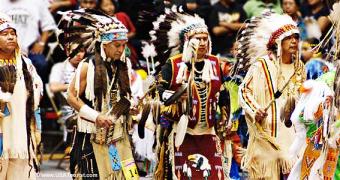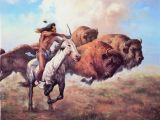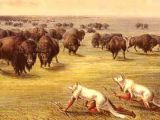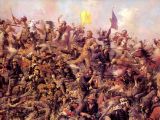Their legends say that they were created from earth, water and stars. DNA says they came from Siberia to what is now Alaska, Canada and US, through a land bridge called Behringia, about 15,000 years ago. Older western movies depicted them as wild and cruel. But in fact, they were victims of the intrusion in their territory of the greediest predator they ever faced: the White Man.
The Native Americans were often called Red Skins. The name traces its roots in Columbus' voyages, when the navigator met the Caribbean natives with an odd red color of the skin. This was due to the ochre they used to slosh their face and body. This misconception was then applied to all indigenous of the Americas, even if the habit is not employed by the natives of North America. In change, some tribes in South America still practice it. Later, the native Americans were named Amerindians, a proper name.
The Red Skins were not an ethnic group, but many tribes and ethnicities with different life styles, over 300 in both Americas. Some were hunters or fishermen, others cultivated the land. They were rather tall (the average height was 1.75 m or 5 ft and 10 in), with robust and muscular bodies, with a light brunette skin, dark and straight hair, and well marked cheek bones. The chin was strong, the nose aquiline, the lips were thin and the sharp black eyes were sunk in the sockets.
The Indian man was hunter and warrior, while women took care of the children, cultivated and harvested crops, grounded grains for making flour and maintained the tents. The main crops of the Amerindians were corn, squash and bean, but all the tribes collected forest products.
In bison hunting tribes, women helped cutting the animals and bringing the meat into the camp, then with its processing for being consumed later. In Apaches tribes, even if men helped in agriculture, women knew best how to do it, with all the required works, prays and flooding technology. Women also mounted and dismounted the tents, which were usually used for two years; the Indian woman was respected and had many rights; even today in some tribes (like Hopi) the woman is the owner of all material goods. The inheritance in many tribes was on the mother's line, and the husband went to live in the house of the bride; in case of divorce, the husband could not take more then his clothes, weapons, pipe, and had to return to the house of his mother. In the Iroquois tribes, women had a lot of power: they could not be the chief of the tribe, but they chose him. Each family was led by the oldest woman. The council of the elder women chose the new chief.
The Indian tribes were in constant war one against the other, except when making alliances between various tribes. As the best way of reaching personal glory was the abundance of war trophies, all young men were eager to start the warrior pathway. The weapons were a bow with arrows, a stone or bone knife, the tomahawk (an ax with a stone cut blade) plus a mace provided with a stone ball, a club resembling a sword and a shield made of wood or bark.
Before a war expedition, the warriors celebrated a feast, a worshiping war dance and rite, destined to check what will be the result of the projected campaign. The tomahawk was the symbol of the war, wielding it meant the hostilities had started, while burying it meant there was a peace accord, confirmed by smoking "calumet", the pipe of peace.
The religion of the Red Skins varied; for some, Sun was the supreme god, others worshiped the goddess of death; others believed in an immaterial and almighty god, called Manitu. Most tribes believed in the power of the dreams, considered revelations made by gods. In the Indian society, there were the shamen, specially endowed people, which had supernatural dreams and visions; to activate this capacity, they devoted themselves to magic dances, rites and ceremonies invoking the spirits; when the exhausted shaman, excited by tiredness and hallucinogen substances fell in trance, the Indians believed a spirit had entered him, and all the shaman said was considered the voice of the gods.
Indians did not know the wheel and they did not have vehicles. To transport their goods while following the bison herds, they used the travois: two sticks joined to one end and diverging to the other. The travois was attached through harnesses to the back of a horse and over the diverging sticks, dragged on the ground, it was placed a web in which the cargo was placed. Before the arrival of the horses, smaller travois were used, dragged by dogs. During the displacements, small children were put in cradles made of birch bark, secured with skin belts. The cradles were placed on the back of the riders.
Navajo women weaved carpets, and this knowledge was transmitted from mother to daughter. They considered that this art was taught to them by the Spider Woman. Some tribes, like Pueblo, were skilled in pottery. They were cotton garments, stitched with yucca fibers. They wore sandals made of yucca, tree bark and agave leaves.
Before going to hunt, men executed dances mimicking the movement of the desired animal (like bear's) for the success of the hunt. Indians completely used the bison's body. From the skin they made portable tents, the harsh tongue was used as a polishing brush and the brain was used for feeding the children. A common animal in the Indian myths and legends was the coyote. Puma skins were appreciated as hunting trophies, signs of bravery and skill. But the supreme trophy was the grizzly bear. The animal was cornered using dogs and it was killed with arrows, or very riskily with the knife in a body-to-body fight, as with a sole paw blow the bear could break the spine of the hunter. The greatest hunt trophy for an Indian was wearing a collar made from the claws of a grizzly bear shot down by him.
During the spring, summer and fall, when there was a lot of grass, bisons formed large herds, while during the winter, the bisons formed smaller groups, looking for remote grasslands. The hunting groups could be formed of several families; the mounted hunters herded the bisons to enclosures, in which they closed the animals and killed them using arrows. During the winter each family hunted alone; when finding a small group of bisons, they were herded using dogs towards a swampy terrain, where they could be easily brought down. Sometimes, the hunters got closer to the bisons disguised and shot down some animals with arrows.
The dwellings of the Indians varied from tribe to tribe, depending a lot on the environment. Penoboscot made huts built from tree bark. Iroquois tribes made long houses from elm bark. Delaware and Nez Perce made huts from reed sheaves. Cherokee made huts covered by elm bark. Seminole made wooden huts covered by palm leaves. Chippewa made huts with reed walls and covered by birch bark. Kicapu made huts of elm bark. Keddo made huts covered by reed. Pawnee made clay houses. Osaj made huts braided from reed. Black foot made tents of bison skin (called tipi), fitting their nomad life style. Tipi were sustained by large posts, stuck in the ground at one end, and converging at the upper end. The tipi was decorated at the exterior with images counting war triumphs and hunting successes of the owner. Inside the tipi, there was the central fireplace.
Pueblo of New Mexico made multilevel adobe houses, as a protection against the scorching heat of the desert. Sometines, the adobe huts were built in natural grottoes. Wichita made grass huts. Maka and Hopi made wooden huts. Pajute made twig huts. Navajo made houses of tree trunks, while Diegueno huts were made of straw sheaves. In Pima, the straw sheaves huts were covered with clay.
At the beginning, American Natives collaborated in the northwestern US with the first European colonists, the English and the Dutch. Jamestown, Virginia, the first British settlement in America, was built with the help of the Powhatan Indians. Without their help, the first English people in the New World would have not resisted to the tough winter of 1607-1608. The pilgrim colony of Plymouth, Massachusetts, was established with the help of the Wampanoag Indians. The Indians showed to the immigrants how to cultivate the land and enjoyed receiving fire guns and steel tools.
But, the massive immigration from Europe and the European methods of land cultivating soon generated tensions with the Indians. The Indians hunted deer, wild turkey, water birds, they fished, and gathered sea food. The colonists started to mow the grass, for feeding cattle and horses, while pigs destroyed clam reserves. The white people changed the environment, in a way that was unsuitable for the Indian way of life.
In Florida, Spaniards had installed in 1513, in smaller groups, taking slaves from amongst the Natives to cultivate the land. The Natives were forced to renounce their religion and pass to Christianity. From the animals introduced by Europeans, only the horse significantly affected the Indian way of life. During the 17th century, Spaniards introduced horses, which escaped in the now southwestern US (Texas and New Mexico). The Amerindians turned into skilled no-saddle horsemen. This way, they could easier hunt bisons with their arrows and the nomad tribes could easier attack the neighboring settled tribes, pillaging them for women and slaves. The horses allowed the Indians to follow the migrating herds of bisons and to increase the size of their tents and the number of domestic tools.
In the 17th century, about 30,000 Narragansett lived in Massachusetts. Their chief, Miantonomo, sniffed the danger and, in 1642, proposed to the Mohawk Indians the formation of an Amerindian resistance alliance. He failed to do this, and next year, during a war, Mohawk captured and killed him. The europeans also took advantage of the conflict between the tribes. During the French-English wars (1756-1763) in North America, various tribes were involved, but no matter who lost, all the involved tribes paid the price of the loser.
Iroquois tribes (like Mohawk, Oneida, Onondaga, Cayuga and Seneca) fought in the British side, during the American Independence War (1775-1783). All they received were insults and abandon at the end of the war, while US got their territory. 40 Iroquois camps were destroyed by the Americans as a revenge, and the survivors had to take refuge in Canada. Even those who fought on the side of the Americans lost: the negotiations took place under the gun point, even if they had not been conquered in that war, and their territories in New York and Pennsylvania were reduced to a small reserve in the New York state. In 1787, a government decree recognized the right to their land of the Indians found north of the Ohio River.
Bribery, menaces, alcohol and manipulations were the weapons through which the Ohio's Delaware, Wyandot, Ottawa, Chippewa, Ojibwa and Shawnee tribes lost their lands.
The Indians did not realize the superior attitude of the Europeans, who looked at them as primitive, heathens and rude. The Native Americans did not understand this; they looked at the White people just as being different, having different values. Land selling was not understandable for the Natives: how to sell air, wind or water? They lived in harmony with nature, without disturbing the natural balance.
Violence gave rise to violence and atrocities occurred in both sides. Indians were feared because of the reputation of taking the scalp. Some think the habit had been triggered by the Europeans giving them gifts for the scalps. This tradition started during the 18th century and continued in the 19th century.
But, Indians fought in an already lost battle; their enemy overwhelmed them in number and weaponry. Still, the greatest enemy of the Indians were not the riffles, but the epidemics brought by Europeans. Europeans got resistance to smallpox, TBC, chicken pox, flue, measles, malaria, yellow fever and typhus, in centuries. In Indian villages, mortality rates reached 80-90 %. A smallpox epidemic turned a Mandan Indian village from 1,600 in 1834 to 130, in 1837. And the smallpox had extended to Hidatsa, Assiniboin, Arikara, Sioux and Blackfoot.
In the new republic of US, Indians had to sell their land or renounce it and to emmigrate or retreat in the reserves. The ethnic cleansing did not forget even the "civilized nations" that had adapted to the habits of the white people.
During the American Civil War (1861-1865), soldiers retreated from the territories of the Navajo Indians. The Navajo took advantage and attacked Mexican and American settlements on the Rio Grande valley. Colonel Kit Carson was sent to solve the issue. To put the Navajo out of the Arizona's Chelly Canyon, he tried to induce hunger on them, burning their crops. 8,000 Indians were forced to make the "Long Way", 500 km (300 mi) to the detention camp Bosque Redondo in Fort Sumner (New Mexico). The cold killed many of the undernourished and poorly dressed Indians, and for shelter inside the reserve, the Navajo had to dig holes into the ground. In 1868, the government gave them 3.5 million acres in Arizona and New Mexico.
Between 1820 and 1845, tens of thousands of Choctaw, Cherokee, Chicksaw, Creek and Seminole were chased away from their lands in the southeastern US and forced to walk to the west, beyond Mississippi, to the lands that now make Oklahoma, located at hundreds of kilometers from their homes. About 25 % died because of the tough winter, hunger, diseases and tiredness. This march was recalled as the Path of the Tears. By 1830, all the territory east of Mississippi was "cleaned" of Indians. In 1832, the US founded the Department for the Problems of the Indians.
The governors said about the dry territories west of Mississippi that "as long as grass will grow green and river waters will flow they will be of the Indians". But this changed when, in 1849, gold was found in California. Thousands of miners crossed with the trains the hunting territories of the Indians and established in Indian territories. When the US army was sent to protect these pioneers, clashes were unavoidable.
The plains' dwellers stood long in front of the white people. Due to the nomad life and the hunting style (being skilled in handling fire guns), they could organize in guerrillas, being hard to find in their territories. Still, they had to retreat and the greatest blow was the massacre of the bison herds, on which they relied for food. People kept just the skin of the animals, without touching their meat, and killed them by the thousands. The hungry Indians had to give up and to accept life in reserves.
In 1868, Red Cloud signs a favorable convention with the US government and keeps the Black Hills territory.
Indians led by Sitting Bull (Tatanka Yotanka) impeded white settlers to mine for gold in the Black Mountains of Dakota. In 1876, lieutenant Custer "Long Hair" thought he could defeat without problems, in Montana near the river Little Bighorn, the about 1,000 Sioux and Cheyenne warriors, with his 650 soldiers. But he made a big counting error, as he faced in fact the largest group of Amerindians which had ever united forces: 3,000. Custer split his cavalry regiment into three and, without waiting help from the other two groups, he attacked with his 225 soldiers the Indians led by Sitting Bull, Gall, and Crazy Horse. The Indians killed Custer, into a shirt victory for the Indians, and a bitter defeat for the American Army. Later, Sitting Bull surrendered for receiving forgiveness.
Instead, he was imprisoned for a time at the Fort Randall, in Dakota. Later, he appeared in the show "Buffalo Bill's Wild West", a shadow of the past. In 1890, he was shot by a Sioux police patrol sent to arrest him.
Also, in 1890, the last Indian resistance was defeated at the massacre of Wounded Knee, in the Great Plains, seen as a revenge for Little Bighorn. About 320 fugitive Sioux men, women and children were killed by the federal troops armed with Hotchkiss guns with rapid shot. The Army had been sent to impede the religious Dance of the Spirits, meant to escape them of the white man and bring them back the bison herds. Humiliated and impoverished, the Indians dwindled in number. Between 1880-1930, Indians lost about 70 % of the land they still had. In 1887, the Dawes Law shared the common land of the Indians in small individual households. In 1924, the Native Americans received US citizenship.
Today, Indians experience acculturation and assimilation. Many chose over the poverty of the reserves that of the slums. Most languages are already extinct or disappearing. Boarding schools contributed to this, as speaking Native languages was forbidden till a few decades ago there. Only 10 persons still speak Karok language of California. In January 1996, Red Thunder Cloud (Carlos Westez), the last speaker of Catawba died at the age of 76, while he could not speak the language with anybody for years.
Today, in US there are 29 colleges for Amerindians, with 16,000 students. At the University "Sinte Gliska", Lakota language is an obligatory matter. Since 1960, the number of Indians started to grow, and by 1990 they numbered 2 million people.
50-85 % of the Native Americans are unemployed, and they have the lowest life hope compared with other ethnic groups in US; they also have the highest rates of diabetes, TBC and alcoholism, connected to cirrhosis, deadly accidents, suicide and crime. In 1967, militant Indians occupied the island of Alcatraz. In 1973, an Indian revolt took place at Wounded Knee.

 14 DAY TRIAL //
14 DAY TRIAL // 


